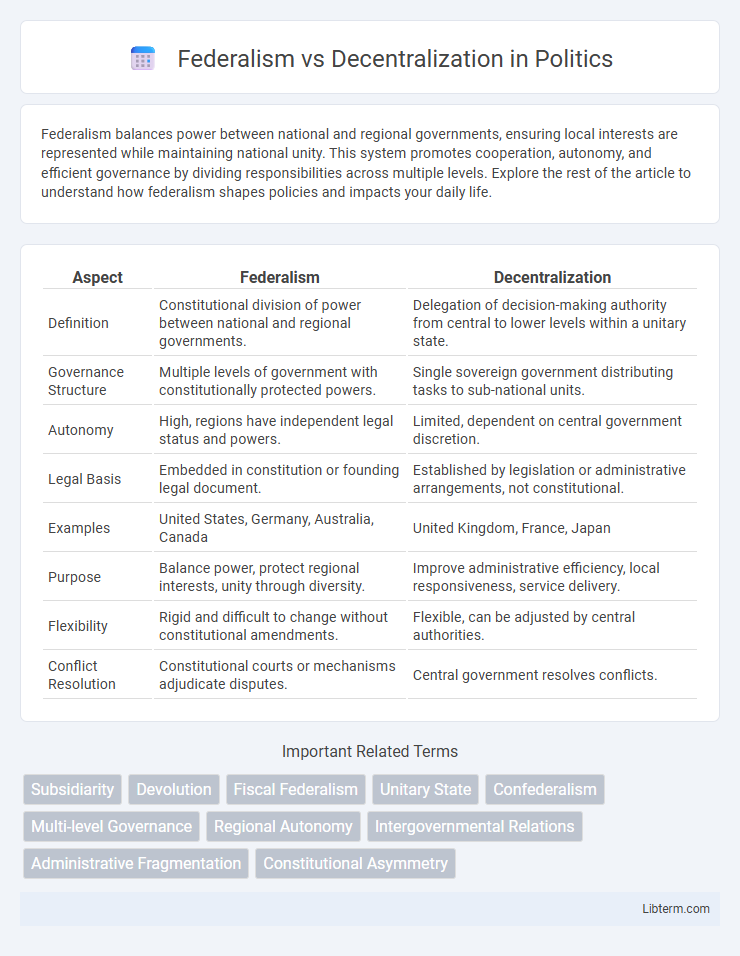Federalism balances power between national and regional governments, ensuring local interests are represented while maintaining national unity. This system promotes cooperation, autonomy, and efficient governance by dividing responsibilities across multiple levels. Explore the rest of the article to understand how federalism shapes policies and impacts your daily life.
Table of Comparison
| Aspect | Federalism | Decentralization |
|---|---|---|
| Definition | Constitutional division of power between national and regional governments. | Delegation of decision-making authority from central to lower levels within a unitary state. |
| Governance Structure | Multiple levels of government with constitutionally protected powers. | Single sovereign government distributing tasks to sub-national units. |
| Autonomy | High, regions have independent legal status and powers. | Limited, dependent on central government discretion. |
| Legal Basis | Embedded in constitution or founding legal document. | Established by legislation or administrative arrangements, not constitutional. |
| Examples | United States, Germany, Australia, Canada | United Kingdom, France, Japan |
| Purpose | Balance power, protect regional interests, unity through diversity. | Improve administrative efficiency, local responsiveness, service delivery. |
| Flexibility | Rigid and difficult to change without constitutional amendments. | Flexible, can be adjusted by central authorities. |
| Conflict Resolution | Constitutional courts or mechanisms adjudicate disputes. | Central government resolves conflicts. |
Understanding Federalism: Core Principles
Federalism organizes government into multiple levels, each with constitutionally guaranteed powers, ensuring both central authority and regional autonomy coexist. Core principles include the division of sovereignty, where states or provinces have exclusive legislative powers, and a written constitution that delineates the scope of authority. This structure promotes political stability, accommodates diverse populations, and allows localized policy-making within an overarching national framework.
Key Concepts of Decentralization
Decentralization involves transferring decision-making authority from central to lower levels of government, enhancing local autonomy and responsiveness. Key concepts include deconcentration, delegation, and devolution, each representing different degrees of power transfer and administrative control. Effective decentralization improves governance by promoting participation, accountability, and resource allocation tailored to local needs.
Historical Roots of Federalism
Federalism originated in the 18th century with the creation of the United States Constitution, designed to balance power between the national government and individual states. Its historical roots trace back to the Articles of Confederation's limitations, prompting a system that allocates sovereignty across multiple levels of government. Unlike decentralization, which disperses authority within a single government, federalism constitutionally divides power, creating autonomous entities with legal sovereignty.
Types and Forms of Decentralization
Federalism divides power between national and subnational governments, establishing constitutionally autonomous entities with legislative, executive, and fiscal authority. Decentralization primarily involves the transfer of decision-making from central to lower levels of government and is categorized into political, administrative, fiscal, and market decentralization, each serving distinct governance functions. Political decentralization empowers local elected officials, administrative decentralization delegates bureaucratic responsibilities, fiscal decentralization allocates budgetary control, and market decentralization involves privatization and service delivery by non-governmental actors.
Federalism vs Decentralization: Main Differences
Federalism is a political system where power is constitutionally divided between a central government and various subnational entities, each with autonomous authority. Decentralization refers to the process of redistributing decision-making authority from central authorities to lower levels of government but without constitutionally guaranteed autonomy. The main difference lies in federalism's constitutional division of sovereignty versus decentralization's administrative delegation of power.
Governance Structures Compared
Federalism divides sovereignty between a central government and constituent political units, each with constitutionally guaranteed powers, enabling multiple layers of authority. Decentralization refers to the delegation of administrative powers from a central government to lower levels, such as regional or local governments, without constitutionally protecting their autonomy. Governance structures in federal systems include autonomous legislatures and courts at subnational levels, while decentralized systems often rely on administrative agencies with limited political independence.
Advantages of Federal Systems
Federal systems offer advantages such as enhanced regional autonomy, which allows states or provinces to tailor policies and regulations to local needs and preferences. This decentralization of power promotes political stability by accommodating diverse populations and reducing conflicts between central authorities and regional governments. Federalism also encourages innovation through policy experimentation, enabling successful local initiatives to serve as models for national adoption.
Benefits and Challenges of Decentralization
Decentralization enhances local governance by granting regional authorities greater autonomy, leading to improved public service delivery and increased citizen participation. It fosters economic development through tailored policies that address specific community needs, promoting efficiency and innovation at local levels. However, decentralization poses challenges such as potential disparities in resource distribution, coordination difficulties between central and local governments, and risks of local elite capture or corruption.
Case Studies: Federalism and Decentralization in Practice
Federalism in countries like the United States grants constitutional authority to subnational governments, enabling autonomous legislative powers and independent courts, which contrasts with decentralization practiced in France, where the central government retains ultimate authority but delegates administrative functions to local authorities. India demonstrates a hybrid model combining federalism with decentralized governance, where powers are constitutionally divided, yet local self-government through Panchayati Raj Institutions promotes grassroots participation. Comparative case studies reveal that federalism ensures formal political autonomy, while decentralization varies in degree and form, influencing policy implementation, resource allocation, and local empowerment differently across nations.
Future Trends in Territorial Governance
Federalism and decentralization are evolving toward more dynamic, multi-level governance structures that emphasize local autonomy while maintaining national cohesion. Emerging trends indicate increased digital integration and participatory mechanisms within territorial governance, enhancing responsiveness and accountability at sub-national levels. These developments signal a future where adaptive, technology-enabled frameworks support more nuanced distribution of powers and resources across different government tiers.
Federalism Infographic

 libterm.com
libterm.com